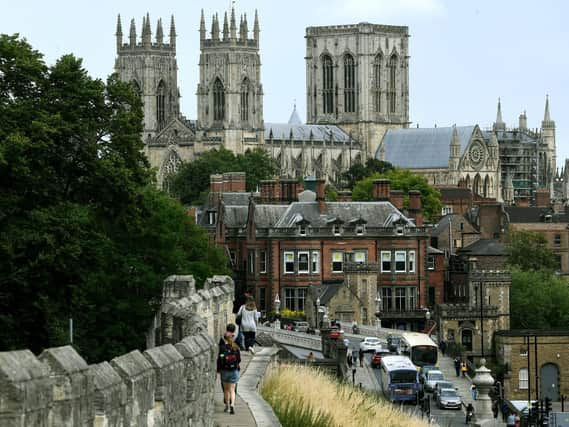Five urban walks in Yorkshire to discover more about our historic cities


To tie in with this month-long campaign, today, we publish a selection of accessible walks from the Walkshire collection.
We hope you enjoy this selection of walks safely and, during the coronavirus pandemic, we urge everyone to follow the Government guidelines and only to travel if it is safe to do so. We also encourage readers to follow the Countryside Code.
1. Blue Loop Sheffield Walk
Advertisement
Hide AdAdvertisement
Hide AdStarts/ends: Blonk Street, Sheffield/Victoria Quays, Sheffield
Distance: 8 miles
Enjoy a long circular walk taking in the industrial heritage and waterways of Sheffield. You begin this walk on the River Don and pass all five weirs of the river. The weirs were built as part of Sheffield’s industrial evolution. When you reach Meadowhall, you will leave the River Don, and pick up the Sheffield and Tinsley Canal.
Once on the towpath you will pass a number of locks and Tinsley Marina. Tinsley Marina came to fame in 1997 by starring in the opening scenes of The Full Monty. As you start heading back into the city centre look out for the street art that has been created.
The art represents the range of people that make up the local community and their stories.
Advertisement
Hide AdAdvertisement
Hide AdDue to Sheffield’s industrial past the waterways have historically been badly polluted. Today, the water quality is much improved, and the area has become a haven for wildlife. Look out for butterflies, kingfishers, herons, salmon and otters on your walk.
If you are looking for a shorter version, the walk can be broken down into smaller circular sections.
2. Hull’s Blue Plaque Trail
Starts/ends: Paragon Interchange, Hull/ Trinity Square, Hull
Distance: 3 miles
With the first plaque having been put up to commemorate the Coronation of Queen Elizabeth II in 1953, there are now over 36 plaques to find on the trail.
Advertisement
Hide AdAdvertisement
Hide AdBefitting of the strong maritime roots that Hull has, the distinctive designs have a nautical appearance with their gold ropework rim and inner circle.
Although not all of them are completely blue, searching high and low for them will make for an enjoyable afternoon for participants of all ages.
Starting at Paragon Interchange you’ll find the first blue plaque. This is a tribute to three of Hull’s most famous musical talents, Mick Ronson, Mick ‘Woody’ Woodmansey and Trevor Bolder of the Spiders From Mars.
You will then travel through the city centre, taking in some of the city’s remarkable architecture, and on to the characterful Old Town and vibrant Fruit Market. From trying to spot England’s smallest window through to the unmissable, imposing architecture of Hull Minster, you will take in all of Hull’s most famous sights finishing back at Trinity House in the heart of the Old Town.
Advertisement
Hide AdAdvertisement
Hide AdWhether you decide to spend time discovering more about the stops that interest you, take in a watering hole or two, or just find all the plaques as quickly as possible, there is no right or wrong way to complete the trail.
3. York River Walk
Starts/ends: North Street Gardens
Distance: 2 miles
Walking alongside the River Ouse will give you a fantastic view of this great city whilst having the peace and quiet of this waterway.
The walk visits Rowntree Park, named after the 19th century campaigner for improved living conditions, Joseph Rowntree, as well as having beautiful views of the medieval York city walls.
This stroll also takes in the modern with views of the York millennium bridge built in 2001 as the newest river crossing point for the city.
Advertisement
Hide AdAdvertisement
Hide AdThe history of the walls are complimented by the 11th century Clifford’s Tower.
Wherever you look on this walk you’ll be taking photos.
4. Bradford City Centre Heritage Trail
Starts/ends: City Park/Little Germany
Distance: 3 miles
We recommend beginning the walk at City Park, but it can be picked up and followed at any point. The first part of the walk should take approximately two hours, although may be a little longer if you choose to include the Little Germany and Cathedral parts of the route.
Bradford City Hall is one of Bradford’s most distinctive buildings. The original building, with its ‘Italianate’ clock tower, was opened in 1873 and was designed by Bradford architects Lockwood and Mawson.
The Wool Exchange symbolises the great wealth and importance which Bradford had gained from the wool trade by the mid-19th century.
Advertisement
Hide AdAdvertisement
Hide AdSt George’s Hall was built in 1851–53 and the first major public building by Lockwood and Mawson. It is a truly grand building, designed as a classical temple on a podium.
Little Germany is a compact area of late Victorian warehouses and offices built on a steep slope and having a highly distinctive character.
The Cathedral Close provides a fine vantage point from which to appreciate the townscape and terrain of the ever-changing city
5. Heritage Corner’s Black History Walk
Starts/ends: Parkinson Building, Leeds University/Clarendon Place, Leeds
Distance: 3 miles
Advertisement
Hide AdAdvertisement
Hide AdLeeds – a magical city in a majestic county. Heritage Corner’s Leeds Black History Walk is a fascinating revelation of historic Yorkshire links to Africa, highlighting a shared and intertwined heritage.
Booking is essential with Heritage Corner. This is a fabulous guided walk run by Joe Williams and Vanessa Mudd. https://heritagecornerleeds.wixsite.com/heritage-corner